|
|
|
|
|
|
6.15.2022
Etruscan Phrases showing Etruscan
conjugation and declension
patterns and vocabulary.
Translation of short inscriptions.
Etruscan_Phrases
Translation
of Short Inscriptions
by Mel Copeland
(from a work published in 1981)
About the
Translation
6.06.09 The words for
the translation below are selected from
the vocabulary, accessed through Indo-European Table 1.
Characters which are underlined are
difficult to read and may not be
correct. This page has been updated to
reflect current results from our etruscan_glossaryA.xls
and Grammar. Those who
would enjoy a more detailed examination
of the translation
pages(>Short_Scripts.f.html) ought to
open the Etruscan_glossary.A.xls
spreadsheet and look up Etruscan words
from it to appreciate the usage of the
word(s) in the various Etruscan texts.
The glossary contains over 2,000
separate words and shows how Etruscan
nouns and adjectives decline and verbs
conjugate.
Script A An
inscription on the location of Tanaqil's
tomb. Tanaqil was the wife of Tarquin the
Great (Lucius Tarquinius Priscus, 5th king
of Rome), from the Etruscan city of
Tarquinii. She was a highborn and
ambitious Etruscan woman who urged her
husband to move from Tarquinia to Rome in
order to advance his fortunes. Her
training in the Etruscan art of augury
often aided her husband in his affairs. At
his death her strong-mindedness and quick thinking assured the throne to their
son-in-law, Servius Tullius, in accordance
with her husband's wishes. She is seen in
another script, DL, "Divinination
Lesson.html" a mirror showing the
divining of a liver before Tarquin, with
the god Veltune (FELTVNE) who is naked and
observing the augur examining a liver.
Next to the augur is Tanaquil, next to her
is Tarquin, holding a staff, and next to
him is another naked god holding a branch
with a sprig growing below his feet. Above
his head is the word, RARLR or DARLR.
thinking assured the throne to their
son-in-law, Servius Tullius, in accordance
with her husband's wishes. She is seen in
another script, DL, "Divinination
Lesson.html" a mirror showing the
divining of a liver before Tarquin, with
the god Veltune (FELTVNE) who is naked and
observing the augur examining a liver.
Next to the augur is Tanaquil, next to her
is Tarquin, holding a staff, and next to
him is another naked god holding a branch
with a sprig growing below his feet. Above
his head is the word, RARLR or DARLR.
A-1 ECA SVTHI (SV I) TANCHVILVS (TAN I) TANCHVILVS (TAN VILVS MAS NIA Le
[Translation: behold! (L. en! ecce!) the
point, pile (L. sudis-is; Fr. soute, f..,
store-room; It. sotto., adv. , prep.
under, below) Tanaquil Masnial (person's
name). This may be the wife of Lucius
Tarquinius Priscus, the fifth king of
Rome. "Tanaquil, a highborn and ambitious
Etruscan woman, urged her husband to move
from Tarquinia to Rome in order to advance
his fortunes. Her training in the Etruscan
art of augury often aided her husband in
his affairs. At his death her
strong-mindedness and quick thinking
assured the throne to their son-in-law,
Servius Tullius, in accordance with her
husband's wishes. " (2) Masnial, name, may
refer to a modern form, as in the name of
the Neopolitan insurgent Tommaso Antiello
Masaniello (1620-1647). VILVS MAS NIA Le
[Translation: behold! (L. en! ecce!) the
point, pile (L. sudis-is; Fr. soute, f..,
store-room; It. sotto., adv. , prep.
under, below) Tanaquil Masnial (person's
name). This may be the wife of Lucius
Tarquinius Priscus, the fifth king of
Rome. "Tanaquil, a highborn and ambitious
Etruscan woman, urged her husband to move
from Tarquinia to Rome in order to advance
his fortunes. Her training in the Etruscan
art of augury often aided her husband in
his affairs. At his death her
strong-mindedness and quick thinking
assured the throne to their son-in-law,
Servius Tullius, in accordance with her
husband's wishes. " (2) Masnial, name, may
refer to a modern form, as in the name of
the Neopolitan insurgent Tommaso Antiello
Masaniello (1620-1647).
P-1 ACIE ZEVS
[Translation: Achaea('s) Zeus] Note: The
word IKIHII,
S cript
T below, a possible variant of
Achaea. Alternatively this could be "water
of Zeus" (L. aqua-ae, water). The "C"
often equates to the "q," rather than a
"k" or "ch." On the other hand Greeks were
referred to as Achaeans. Homer generally
referred to all the Greek forces as
Achaioi, but also listed the Myrmidons and
Hellenes, who were led by Achilles. (2) cript
T below, a possible variant of
Achaea. Alternatively this could be "water
of Zeus" (L. aqua-ae, water). The "C"
often equates to the "q," rather than a
"k" or "ch." On the other hand Greeks were
referred to as Achaeans. Homer generally
referred to all the Greek forces as
Achaioi, but also listed the Myrmidons and
Hellenes, who were led by Achilles. (2)
AB-1 MI MVLV LARI SALE FEL KAINA SI (Text from
Archaeologica, "Scritti in onore di Aldo
Neppi Modona / A cura di Nelide
Caffarello," L. S. Oshchki, Firenze, 1975,
p. 207) [Translation: to myself, mine, my
(L. meus-a-um; mihi, Dat. It. mi, myself))
I construct/stir/toil (L. molior-iri) of
the gods (L. Lar, SI (Text from
Archaeologica, "Scritti in onore di Aldo
Neppi Modona / A cura di Nelide
Caffarello," L. S. Oshchki, Firenze, 1975,
p. 207) [Translation: to myself, mine, my
(L. meus-a-um; mihi, Dat. It. mi, myself))
I construct/stir/toil (L. molior-iri) of
the gods (L. Lar,  laris)
of the hall (It sala, f.), or
alternatively, you go up (It. salire,
sale, he goes up; L. salio, salire) of the
great Chaina himself , itself (It. si)] laris)
of the hall (It sala, f.), or
alternatively, you go up (It. salire,
sale, he goes up; L. salio, salire) of the
great Chaina himself , itself (It. si)]
Note: LARI is one of the words on the
Piacenza Liver. FEL KAINA may be Vulcan
(L. Volcanus-i (Vulcanus-i). This may also
refer to Chianciano Terme. The website of
its museum says:
"Chianciano Terme stands on a hilltop
overlooking to the west the fertile Chiana
valley, already mentioned by Latin authors
for its varied and abundant crops. In the
vicinities of the present Chianciano,
close to the ancient road that connected
Northern Etruria's inland to the coast, a
rather sizeable Etruscan settlement must
have developed that controlled this
important route running through the
Astrone Valley. The presence of warm
healing springs in the area must also have
played a role in the development of the
Etruscan Chianciano, since the area was a
centre of the cult worship of Apollo as
early as the 5th century B.C." [See http://www.chianciano.com/museo/etrusco/museo-uk.htm
and http://www.tuscanholidays.net/villas-tuscany-chiana-valley.htm]
CHIANA declines as CHIANE at TC109.
AD-1 MI MAMAR CES FEL THIE NAS [Translation:
to myself (It. mi) Mamar I stop (stop,
cease (L. ceso-are) the great of the days
(L. dies-ei, m.) born ( L. nascor-i, natos
and [gnatus); or possibly the great
Thienas, Dienas, person's name.] Note:
Mamar may be Mermerus, the elder son of
Medea and Jason or possibly the grandson.
Medea was gifted in making poisons. Medea
and Jason had two sons, Pheres and
Mermerus who were abandoned by Medea at
the altar of Hera after her murder of
Corinth's king and his daughter. The two
children had innocently carried a poisoned
robe to the king's daughter, Glauce. The
Corinthians stoned the two children to
death. The art of making poison was passed
down to the son of Pheres, Mermerus, who
was the king of Thesprotian Ephyra. He
passed the art down to his son Ilus. Ilus,
king of Ephyra, refused to sell arrow
poison to the young Odysseus.
AE-1 NAS: ARNO LARIS AL: FILAO: [Translation: born
(L. nascor-i) Arno, name of gens and of
chief river in Etruria (L. Arnus-i, m.) of
the gods (L. Lars, Laris) to him (It. al)
son (L. filius-i)] LARIS AL: FILAO: [Translation: born
(L. nascor-i) Arno, name of gens and of
chief river in Etruria (L. Arnus-i, m.) of
the gods (L. Lars, Laris) to him (It. al)
son (L. filius-i)]
AE-6 IYC KaNAL RIP [Translation: of a
knight (L. eques-itis) or I yoke, bind (L.
ugo-are) the channel (L. canalis-is; It.
canale, m.) bank, shore (L. ripa-ae) ]
Script AF (left) Pillaster, tomb of the
Clautie, Caere, 4th Cent. B.C.
AF-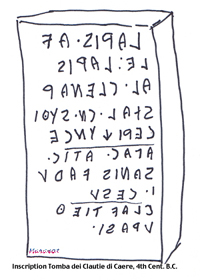 1 LARIS 1 LARIS AFLE: LARIS AL AFLE: LARIS AL CLENAR STA Le) CLENAR STA Le) CN CN SVTHI CERI KVNCE [Translation: to
the gods (L. Lars, Laris) the prince (L.
aule) of him (It. al) to Clenar (person's
name; see CLENeRVN, K64) he stands,
stations (L. sto, stare) there (Fr. la);
CN; underneath, below (Fr. soute, f.; It.
sotto., adv. , prep. under, underneath,
beneath, below; L. sudis-is, point, pile)
you bewailed (L. queror, queri) the
sea-shell? (L concha-ae)] SVTHI CERI KVNCE [Translation: to
the gods (L. Lars, Laris) the prince (L.
aule) of him (It. al) to Clenar (person's
name; see CLENeRVN, K64) he stands,
stations (L. sto, stare) there (Fr. la);
CN; underneath, below (Fr. soute, f.; It.
sotto., adv. , prep. under, underneath,
beneath, below; L. sudis-is, point, pile)
you bewailed (L. queror, queri) the
sea-shell? (L concha-ae)]
AF13 APA Ce ATIC ATIC SANIS FA RVI SANIS FA RVI CESV [Translation: he
goes away (L. abeo, abi-itum) to us (It.
ce) to Attica (L. Attica-ae) healthy/sound
(pl.) (L. sanus-a-um) you go? second pers.
It. & Fr. aller, va?) of the king (Fr.
roi, m.); to cease work/rest (L.
cesso-are)] CESV [Translation: he
goes away (L. abeo, abi-itum) to us (It.
ce) to Attica (L. Attica-ae) healthy/sound
(pl.) (L. sanus-a-um) you go? second pers.
It. & Fr. aller, va?) of the king (Fr.
roi, m.); to cease work/rest (L.
cesso-are)]
AF-20 CLAF TIE THVRASI [Translation: the
staff, club (L. clava-ae; It. clava;
clavus-i, nail, spike, tiller, helm,
stripe of purlbe worn by senators and
knights) of the day (L. dies-ei, day; diu,
by day; diutiuus, longer; Welsh, dydd;
Scot, di) of the Thorasi, name; Re:
Dores-um, wife of Nereus; meton., the
sea]]
Note: This pillaster from the tomb of the
Clautie in Caere confirms the word and its
meaning of Suthi, also used in Script A-2
which identifies the place of Tanaquil's
tomb (Script A, above).
AG-1 FEL A TIES:
FEL RVDVS LEMNISA: CELA TI: CESV
[Translation: the great (Fel) at (L. a)
the day (L. dies-ei, m. or f.);
alternatively this 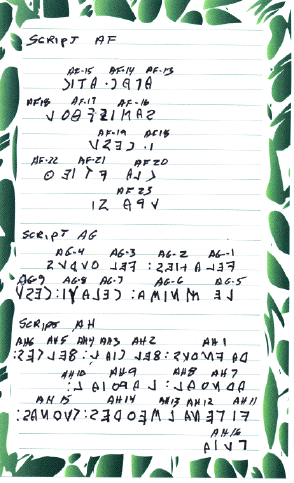 could be Fel Aties (the
great Attis / Atys, pl.; See the Atyad Dynasty, Lydia
the great Rudus (L. rudis-e, rough, raw,
uncultivated, unrefined, unskilled,
awkward) the Lemnian (L. Lemnos [us]-i;
adj. Lemnius-a-um, Lemnian) you (pl.)
hide (L. celo-are; celati, 2nd pers.
pl.); to cease work/rest/stop / I stop?
(L. ceso-are)] could be Fel Aties (the
great Attis / Atys, pl.; See the Atyad Dynasty, Lydia
the great Rudus (L. rudis-e, rough, raw,
uncultivated, unrefined, unskilled,
awkward) the Lemnian (L. Lemnos [us]-i;
adj. Lemnius-a-um, Lemnian) you (pl.)
hide (L. celo-are; celati, 2nd pers.
pl.); to cease work/rest/stop / I stop?
(L. ceso-are)]
AT-1 (was AH-1 ) RAFeN (or RAUN) RVS: 8ELCIA Le:
8ELCES: ARNO AL: LA ROIAL: FIPENA Le SER RES: CVRNAS: PVIA
[Translation: they ravish , seize (L.
rapio, rapere; third pers. pl, rapiunt)
the country (L. rus, ruris); (the town
of) Velcha (Vulci, on the river Fiora)
there; the Velches (People of Velches,
Vulci?); the (river) Arno to the, to it
(It al); there (It. la) the king (Fr.
roi ) to it (It. al) or alternatively
royal: royal, regal, kingly) Vipena
(Vipinnas) I connect, join (L. sero,
serere, serui, sertum) the matter/thing
(L. res, rei); the horn/courage (L.
cornu-us) afterwards (It. poi; Fr.
puis)]
Note: This text links directly to an
inscription above warriors in the
Francois Tomb of Vulci. Here we are told
that Vipena is of the royalty of Vulchi.
It is also implied that they had
influence from the Arno river to the Poe
(which doesn't make sense, since Vulchi
was in the far south of Tuscany, on the
Fiora river.
AJ-1 MELI ARNOI ARNOI PVIA PVIA AMCE AMCE SPI SPI IPS [Translation: the
honeys/sweetnessess (L. mel, mellis) of
the Arno (L. Arnus-i, m. chief river of
Etruria; people of the Arno?) aft IPS [Translation: the
honeys/sweetnessess (L. mel, mellis) of
the Arno (L. Arnus-i, m. chief river of
Etruria; people of the Arno?) aft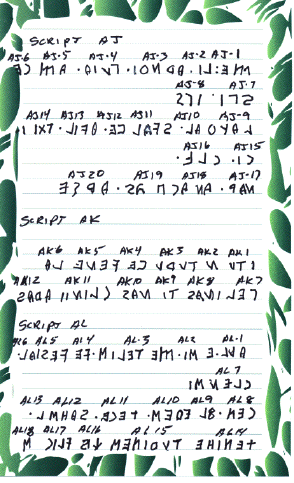 erwards/then (It. poi; Fr.
puis) in a friendly manner (L. amice and
amiciter); the hopes (L. spes-ei, f.) or I
hoped (L. sperare) I myself/of my own
accord (L. ipse-a-um)] Note: The IA sufix
in PVIA coincides with noun, gen. endings. erwards/then (It. poi; Fr.
puis) in a friendly manner (L. amice and
amiciter); the hopes (L. spes-ei, f.) or I
hoped (L. sperare) I myself/of my own
accord (L. ipse-a-um)] Note: The IA sufix
in PVIA coincides with noun, gen. endings.
AJ-9 LAYO AL SFA Le CE SFA Le CE AFIL AFIL LXII CI LXII CI CLF CLF [Translation: to
bathe/wash (L. lavo, lavare, lavere, lavi,
lautum or lotu or lavatum) at the/at it
(It. al) she joins together (L. suo,
suere, sui, sutum) there (Fr. le, la) to
us (It. ce); she lived/possessed (L.
habeo-ere-ui-itum) 68 [years] of which,
that (L. qui, interog.; qui, quae or qua,
quod) I am named (L. clueo-ire)] [Translation: to
bathe/wash (L. lavo, lavare, lavere, lavi,
lautum or lotu or lavatum) at the/at it
(It. al) she joins together (L. suo,
suere, sui, sutum) there (Fr. le, la) to
us (It. ce); she lived/possessed (L.
habeo-ere-ui-itum) 68 [years] of which,
that (L. qui, interog.; qui, quae or qua,
quod) I am named (L. clueo-ire)]
AJ-18 NAR ANA CNVS ANA CNVS ARCE [Translation: I
say/make known (L. narro-are); Anna of
Cnaeus you lead (Gr. archo, to command,
rule; archon, leader; L. auctor-oris,
originator). ARCE [Translation: I
say/make known (L. narro-are); Anna of
Cnaeus you lead (Gr. archo, to command,
rule; archon, leader; L. auctor-oris,
originator).
Note: The colon in AJ-1, ME: LI, is not a
punctuation mark, since the dot ( ) is the punctuation
mark used throughout the text. ARCE
declines and its declensions are used
extensively throughout the Etruscan texts
in the context of a leader. ) is the punctuation
mark used throughout the text. ARCE
declines and its declensions are used
extensively throughout the Etruscan texts
in the context of a leader.
AK-1 ITVN TVRV CE FENE LAPE (or LATE) LINAS TI
NASC LINII ARAS [Translation:
they go (L. ito-are) to look after (L.
tueo-ere) of us (It. ce); you come (L.
venio, venita, veni, ventum); you
totter, waver be about to fall, sink,
(L. labo-are) or alternatively you
glide, fall down, fall away, decline,
make a mistake (L. labor, labi, lapsus)
or you prai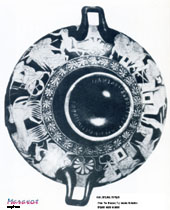 se/commend
(L. laodo-are) of Linas (person's name)
yourself (It. ti) I am born (L.
nascor-i, natos and [gnatus] of the
Linii (family of Linas) of the altars
(L. ara-ae)] Click on image for larger
view. se/commend
(L. laodo-are) of Linas (person's name)
yourself (It. ti) I am born (L.
nascor-i, natos and [gnatus] of the
Linii (family of Linas) of the altars
(L. ara-ae)] Click on image for larger
view.
Script AL, Aule Metelis,
from Sanguineto, Italy, near Lake
Trasimene, 1st. c B.C.
AL-1 AULE (AF LE) LE) METELIS METELIS FE FE FELES IR Le FELES IR Le CLENSI [Translation: the prince (L.
aule) himself , Metelis you carry (L. veho,
vehere, vexi, vectum) perhaps (L. ve,
perhaps) or Felsi, place? or
skirmishers, light-armed infantry (L.
veles-itis or velites) to go (L. iri)
there (le) of the Clensi (peoples' name)] CLENSI [Translation: the prince (L.
aule) himself , Metelis you carry (L. veho,
vehere, vexi, vectum) perhaps (L. ve,
perhaps) or Felsi, place? or
skirmishers, light-armed infantry (L.
veles-itis or velites) to go (L. iri)
there (le) of the Clensi (peoples' name)]
AL-8 Le ERES : TECE ERES : TECE SANS Le SANS Le V_ _ _?
[Translation: you err, wander (L
error-are) you cover, bury (L. tego,
tegere, texi, tectum) the healthy (L.
sanguis-itis, m. and sanguen; It.
sangue, m.; Fr. sang, m.; or healthy (L.
sanus-a-um) there (le); ........... ] V_ _ _?
[Translation: you err, wander (L
error-are) you cover, bury (L. tego,
tegere, texi, tectum) the healthy (L.
sanguis-itis, m. and sanguen; It.
sangue, m.; Fr. sang, m.; or healthy (L.
sanus-a-um) there (le); ........... ]
AL-15 TVRINES KIS FLICS ...[Translation:
the people of Turin (L. Augusta
Taurinorum) whom (L. quis, quid; It.
chi, Fr. qui) I change, alter, bend (L.
flecto, flectere, flexi, flexum) (1)
The script is
located on the rear, bottom of the toga
of the orator, Prince Metelis..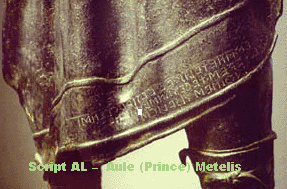
Script
TA. This script is in the "Tomb of
the Augurs," Tarquina.
The inscriptions cannot be easily
read and were only visible to me
through a watercolor of the mural
in a book by Frederik Poulsen, Etruscan
Tomb Paintings, Oxford, The
Clarendon Press, 1922. The paint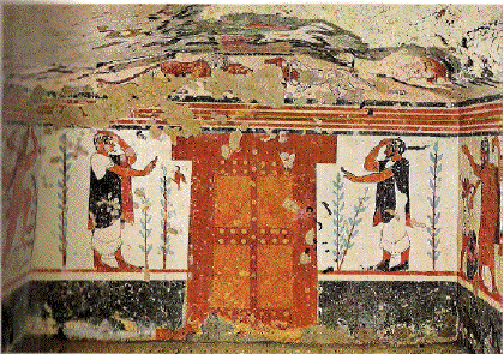 ing is
part of a collection Ny Carlsberg
Glyptotek. The frescos in the
Etruscan tombs have been
deteriorating, and it may be that
the early water-colors will be our
final point of reference on the
inscriptions in various Etruscan
tombs. Artists, by their nature,
copy what they see, and in this
case the artist saw an inscription
the camera several years later
could not copy. The right hand
figure has the following
inscription to the left of his
head: ing is
part of a collection Ny Carlsberg
Glyptotek. The frescos in the
Etruscan tombs have been
deteriorating, and it may be that
the early water-colors will be our
final point of reference on the
inscriptions in various Etruscan
tombs. Artists, by their nature,
copy what they see, and in this
case the artist saw an inscription
the camera several years later
could not copy. The right hand
figure has the following
inscription to the left of his
head:
TA-1: APA STA PASAR
Translation: [the priest (It. abate [m],
abbot, priest; Fr. abbé [m], abbot), he
stands (L. sto, stare, steti, statum; It.
stare; Fr. stationner) to pass (It.
passare; Fr. passer)]
The left-hand person has an illegible
inscription to the right of his head:
TA-4: TAN......
The word APA is used in other scripts and
appears to be a verb.
Funerary inscriptions in
the Tomb of "Aninas," Tarquinia
(Script AN):
Script AN(1):
AN-1 ANI NAS: ARNO: FELV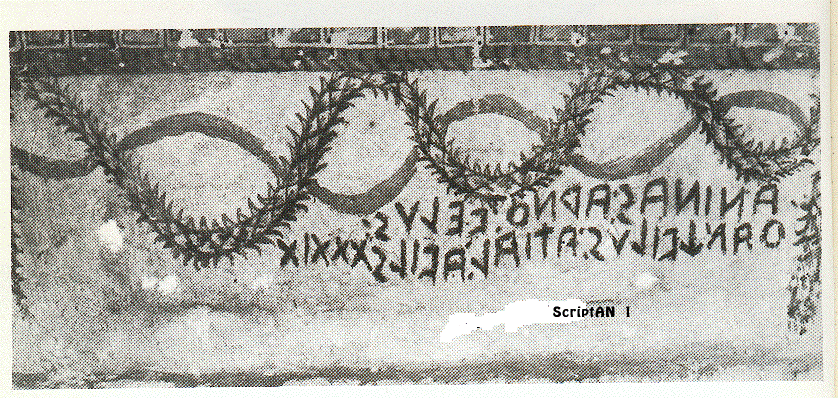 S: [Translation: name, Ani, born (L. nascor-i,
natos and [gnatus]) of the Arno (L.
Arnus-i, m. chief river of Etruria,
now the Arno); of the fleece, hide (L.
vellus-eris)] S: [Translation: name, Ani, born (L. nascor-i,
natos and [gnatus]) of the Arno (L.
Arnus-i, m. chief river of Etruria,
now the Arno); of the fleece, hide (L.
vellus-eris)]
AN-5 ORAK FILVS: ATIA Le: AFILS XXXIX
[Translation: I demand (L. proco-are)
of the son (L. filius-i, m.) of Atia
there; she possessed/lived (L
habeo-ere-ui-itum) of 39 (years)]
Note: ORAK - The R and A seem to have
been written over, as if a spelling
error had ocurred.
Script AN(2):
AN-12 ANI NAS: FEL: FELVS: A PANES: SVR NVS
[Translation: name,
Ani, born (L. nascor-i, natos and
[gnatus])
great of the
fleece,
hide (L. vellus-eris) to (L. a) name,
Panes, or alternatively, you compose,
fasten (L. pango, pangere) of sister
(L. soror; It. suora, f. Fr. soeur,
f.) our (L. nos; Fr. nos; It. nostro,
nostri, nostra, nostre)] Note: the
phrase, great of the hide may be an
expression referring to a great
writer, since sheep skin (vellum) was
used to write upon.
A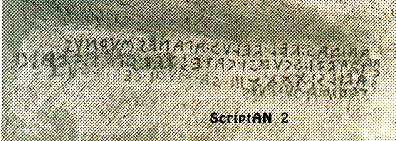 N-20 AL øA (PHA) ESI: SCVRPI:
CATES: TEFS: A _ _AF ALCE
[Translation: to her (It. al, prep.
to the) the goddess Pha you went out
(It. escire [uscire]; L.
exeo-ire-li-[ivi]-itum) of the month
of the Zodiac, Scorpio (about
October 24-November 29; in Babylonia
it is regarded as the 8th month,
October-November; L. Scorpio-onis
and Scorpios [-os] -i; Scorpius was
responsible for killing the hunter
Orion and the two constellations
never appear at the same time in the
sky. When Scorpius rises Orion is
setting. Its brightest star is
Antares, "rival of Ares, Mars."); N-20 AL øA (PHA) ESI: SCVRPI:
CATES: TEFS: A _ _AF ALCE
[Translation: to her (It. al, prep.
to the) the goddess Pha you went out
(It. escire [uscire]; L.
exeo-ire-li-[ivi]-itum) of the month
of the Zodiac, Scorpio (about
October 24-November 29; in Babylonia
it is regarded as the 8th month,
October-November; L. Scorpio-onis
and Scorpios [-os] -i; Scorpius was
responsible for killing the hunter
Orion and the two constellations
never appear at the same time in the
sky. When Scorpius rises Orion is
setting. Its brightest star is
Antares, "rival of Ares, Mars.");
of the family of Cato; god, (L. m.
deus, divus) ......of
something/someone/anyone (L.
aliquis, aliquid)]
AN-28 AFILS
XXXXIII SA SVRI: CERIS VNCE
[Translation: she lived/possessed
(L. habeo-ere-ui-itum) 47 (years)
herself (L. se, or sese, acc. sing.
and pl. sui, genit., sibi, dat. se
or sese, abl.) smiled (L.
risor-oris; It. sorridere; Fr.
souire); the goddess Ceres (L.
Ceres-eris) you anoint (L. ungo
[unguo] ungere; It. ungere; Fr.
oindre)]
AN-35 SANIM ............unreadable.
Script
AN(3): AN-34 ANI NAS: LARO FELVS: ARS NAL
[Translation: name,
Ani, born (L. nascor-i, natos and
[gnatus]);
the ghost (L. arua [larua]-ae, f.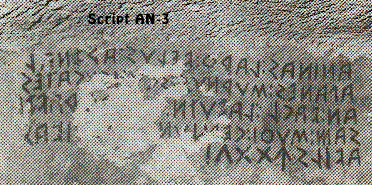 ) of the the fleece, hide (L.
vellus-eris)
the skill/character (L. ars-tis, f.)
of the passage money (L. naulum-i)] ) of the the fleece, hide (L.
vellus-eris)
the skill/character (L. ars-tis, f.)
of the passage money (L. naulum-i)]
AN-40 A
PANES: SVRvM SIS CFS ICV CATES
[Translation: to (L. a) Panes,
or alternatively, you compose,
fasten (L. pango, pangere) of
the sisters, sister (L. soror;
It. suora, f. Fr. soeur, f.) you
wish (L. vis) Cus to strike,
slay (L. icio or ico, ici,
ictum) of the family of Cato]
AN-47 AN:
FAC Le: LAFV TN: RAF SI
[Translation: whether (L. an) I
make/do (L. facio, facere, feci,
factum) there (le) to bathe (L.
lavo, lavare, or lavere, livi,
lautu or lotum or lauatum) of TN
(abbreviation for the god Tini);
I snatch away/hurry along (L.
rapio, rapere, rapui, raptum)
herself (It. si; L. se, or sese,
acc. sing. and pl. sui, genit.,
sibi, dat., se or sese)]
AN-54 SAM SVRI CENKVN_ _ _ _ _
_CIFAS [Transaltion: the leg
(It. zampa, f.; Fr. jambe) you smiled (L.
risor-oris; It. sorridere; Fr.
souire) Cenchun,
name or alternatively, they
think, estimate (L. censeo,
censere) .........of food (L.
cibus-i, m.) or alternatively
the citizens (L. civis-is)]
AN-59 AFILS
Ki XXVI
[Translation: she
lived/possessed (L.
habeo-ere-ui-itum) some (L.
quae, or qua) 26 (years)]
Inscription
from Pesaro of L. F.
Matius, Fulguriator, an
augur who interpreted
lightening bolts
Latin
inscription (top) Matius
L. F. he would stand (L.
sto, stare, steti, statum,
stet, 2nd Pers.subj.) the
prophet/seer (L.
haruspex-spicis, m.) the
priest who interpreted o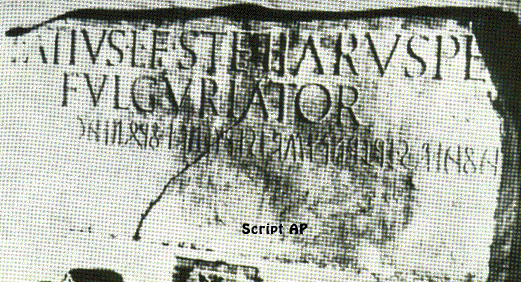 mens from
lightening (L.
fulgurator-oris, m.) mens from
lightening (L.
fulgurator-oris, m.)
Script AP-1
AVA (A8A), IPS ERFR NIV SFIS TRYINFI
8eRVNIA Ce
[Translation: A8A,
farewell, hail!, L. ave,
avete, IPS, himself or the
master, L. ipse-a-um, to
uproot, rescue, L. eruo
-ere, to weave, L.
neo-nere-nevi-netum, Ind.
Pres. 1st Pers. Sngl. neo,
SUIS (MFIS) you join
together, suo, suere, sui,
sutum, Ind. Pres.
Suis, the Trojans (L. Nom.
Pl. Troiani, Troinui; of
Verona, 8eRVNIA Ce; of
Verona to us (It. ce).
Note the "ia" suffix is a
common suffix of proper
names.
|
|
Script HA, on an
augur (haruspex) Vatican Museum (left):
HA-1 TN: TUR CE (TVRCE) FEL
SUEITUS (SFEITVS) [Translation [TN, an
abbreviation used also in the Zagreb
Mummy Script; Torce (name, possibly
having to do with to twist, L.
torqueo-torquere, to curl, twist, wind)
the great Sueitus (name, based on L.
suesco, to be accustomed; or Suebi-orum,
a German people; or related to Roman
name, Suetonius-i, ] CE (TVRCE) FEL
SUEITUS (SFEITVS) [Translation [TN, an
abbreviation used also in the Zagreb
Mummy Script; Torce (name, possibly
having to do with to twist, L.
torqueo-torquere, to curl, twist, wind)
the great Sueitus (name, based on L.
suesco, to be accustomed; or Suebi-orum,
a German people; or related to Roman
name, Suetonius-i, ]
(Right) Script LF,
bronze in the Louvre, Museum:


LF-1: TV
LF-2 SVRISA
[Translation: you
(L. tu) Surisa, name or alternatively,
you smiled (L. risor-oris; It.
sorridere; Fr. souire) yourself (L. se,
sese)]
See SVRI AN-30
|
|
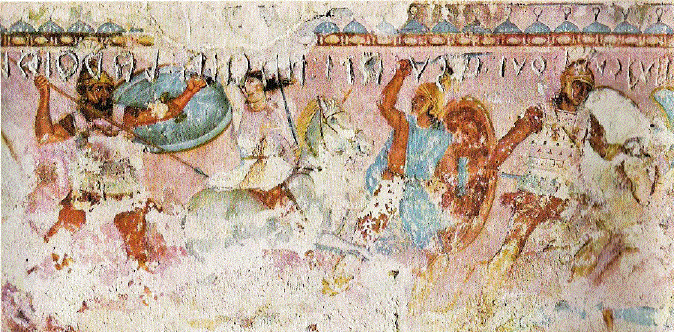
Script AM,
"Battle of the Amazons,"
Sarcophagus from Tarquina,
Archeological Museum, Florence. Photo
from Skira, Inc., Etruscan
Painting, 1952. This painting
obviously involves a woman and
warriors, and the text should explain
who is involved and what is happening
in the scene. The woman does not
appear to be wearing armor, and the
semi-naked warrior in blue also has no
armor, has a Phrigian helmet, and
brandishes a sword towards the woman.
On the other side of the woman is an
armored soldier pointing a spear at
the woman. The armed man, carring a
bow, on the far right is actually
leading the group away. The scene
suggests the capture of the woman, not
necessarily a battle. It may depict an
abduction.
When Etruscan murals depict
mythological scenes, they tend to be
familiar to Greek stories. Thus, we
should be able to relate this scene to
a Greek myth, particularly an
abduction, and probably relating to
the Trojan War.
As
of 8.22.06
The first word is huc (L. huc, here
is) and the next word would call for a
name, and the suffix, ai, suggests a
proper name, as in the name of Helen
in the Divine Mirror.html:
ELINAI. Here, the word appears to be
CRAI. Also, we have the name CNEI,
whose suffix suggests a feminine name,
as in PHERSIPNEI (Persephone, Queen of
Hades; See Etruscan Mural,
Orcus.gif). In this version the
names Crai and Cnei are not familiar
to me. If ASV is Asius, brother of the
famous Hecuba known also as Hecate
then we should be able to find
somewhere a story of him abducting a
beautiful woman. Hecuba was the wife
of King Priam and she was one of the
Trojan women who were abducted by the
Greeks (she became the slave of
Odysseus). On his homeward voyage he
stopped on the shores of the Thracian
Chersonese, ruled by King Polymestor,
a former Trojan ally. Hecuba
discovered that Polymestor had
treacherously murdered her son
Polydorus for his gold. She lured the
king to her tent and blinded him,
after killing his infant sons. Shortly
thereafter Hecuba was transformed into
a fiery-eyed dog. The dog's grave
became well known to sailors as
Cynossema or Cyneus.
According to the lost epic "Sack of
Ilium," Apollo brought Hecuba at last
to Lycia. Cnei may thus be the name of
Hecuba, as Cyneus. If ASV is Asius, it
would not be likely that he would be
participating in the abduction of his
sister, Hecate. If the warrior on the
left, with the spear, is Asius, he
could be defending Hecate (Cyneus,
CNEI) against king Crai.
The abduction of the Trojan women was
a popular theme in mythology.
The woman appears to be holding a
sword in her right hand and defending
herself. She does not have her right
breast exposed, as was the custom of
the Amazons (They cauterized the right
breast of young women so to not
interfere with shooting an arrow,
according to Herodotus). Strapped to
her side appears to be a scabbard for
the sword. If we compare this scene to
the painting on the opposite side of
the sarcophagus (Amazons.gif), it
is clear that the scene involves an
Amazon in battle with warriors. In
this panel, however, the warrior seems
to be wearing a Phrygian style helmet.
Cmpare his helmet to those of the
armored soldiers.
This might be the "Battle of the
Amazons" when they invaded Athens.
Theseus had abducted Antiope (or
Hippolyte) who was either the Amazon
queen or her sister, and took her to
Athens. The Amazons invaded Athens in
pursuit of their queen.
Later the Amazons fought the Trojans
led by young King Priam, and the
Mygdonians and Phryigians. Perhaps
because the Amazons hated the Greeks
more than they did the Trojans, their
queen, Penthesileia, came to the aid
of Priam late in the Trojan War. She
was killed by Achilles, but only after
inflicting much damage on the Greeks.
It would make sense that both scenes
on the sarcophagus represent both
phases of the incident: the abduction
of Antiope by Theseus and the Amazon
attack on Athens to recover her. Since
both the Greeks and Trojans wore
crested helmets according to the Iliad
the warriors could be either Greek or
Trojan.
The text should
provide a clue to the scene, which
battle of the Amazons is involved.
Sometimes there is a recognizable
correspondence of Greek names to the
Etruscan spelling and thus we would
look for familiar names involving the
Amazons. Other names, such as those
seen on the Divine Mirror.html,
like the Etruscan Turan, who is the
Greek Aphrodite, Roman /Venus, or
Tinia who is the Greek Zeus, the Roman
Jupiter, are not similar.
Only the characters Asius (ASV) and
Cyneus / Hecate (CNEI) seem to have a
bearing in this Etruscan scene. If
Hecate is the woman in the scene, then
her abductor would be Odysseus, whose
name is not mentioned. If the woman is
an Amazon, she would have to be a
famous Amazon, but no name in the
script coincides with those names
listed above. In the conflicts
involving the Amazons, Hercules
(Etruscan, Hercle) or Theseus
(Etruscan, These) were the abductors
of Antiope, and their names are not in
this panel. So this is not the
abduction of Antiope. If the woman is
Penthesileia, then something close to
her name, and particularly the name of
Achilles, should be mentioned. I thus
lean towards the theme of the
"Abduction of the Trojan women," with
this scene relating to Hecuba. The
opposite panel contains no text but
certainly appears to relate to the
Amazon revenge attack on Athens.
(1) AM-1 HVC CRAI: RVI: ASV ATI: TIFI
CNEI: LAR RIAL [Translation: Hither
is, to this place (L. huc) Crai the
king (L. rex, regis; It. re, Fr. roi).
Aso (Asius, a Trojan ally. Asius was
the younger brother of Hecuba and son
of Dymas, king of the Phryigian tribe
who lived on the Sangarius River. He
led that nation's forces in the Trojan
War) of the Ati (sons of Atis). He
carried away (L deveho -veheree -vexi
-vectum) or alternatively divine (L.
divus-a-um) of Cnei: of the god (L.
lar) royal (L. regalis)] Note: A
letter faces towards the word it
belongs when there is a chance of
confusing it with the following word;
i.e., HVC CRAI and not Ce CRAI. AI is
a genitive suffix identifying proper
names.
Script T
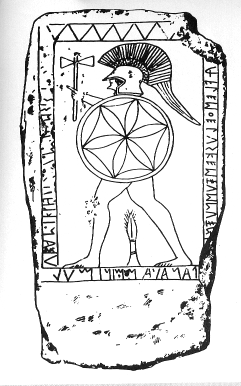 Inscribed
funerary stele, illustration of the
Vetulonia "Warrior's Tombstone" Inscribed
funerary stele, illustration of the
Vetulonia "Warrior's Tombstone"
Museo
Archologico, Florence.
6th-7th century B.C. From The
Etruscans, Massimo Pallottino,
Indiana University Press, 1975 This I
have identified as Script T. Compare
his armour to that used in the Illiad
of Homer.
The script,
called the Avle Feluske stele, is
not of Avle Feluske. It is: of AULE
SeRELUS:
T-1 AULE (AFLE) SeRELVS KESTVS NVS NI _ _
_ _ _PANATAM MINIMV Le VBAN IKIHII _
_ _ _SIS The last part of the script
is not readable. As will be
evidenced in this site the scripts
used The S is a  . The S is a . The S is a  . .
The other "S"
in the script is the S.
[Translation: Prince (L. aule)
Serelus a lamentation (L.
questus-us); our (L. nostri) .ni..of
the deities (L. Penates-ium) the
least (It. minimo; L. minimus) there
(la). They die, go to meet (L.
obeo-ire) of Achaia (L. Achaia-ae)
....I wish, will (L. sis).
Notes:
(1) AL16
should read KIS ( IS). AL17-AL18, FLICS,
appears to be L. flecto,
flectere, to bend, change or
possibly L. flo, flare, flavi,
flatum, to blow, to cast metals
. The "V" or "B" is an "8."
AL9-AL10, 8eLERES (Veleres), is
a common name/ephitet to script
Z, the Zagreb Mummy with about
18 usages. This script will be
updated as I learn more about
the vocabulary. IS). AL17-AL18, FLICS,
appears to be L. flecto,
flectere, to bend, change or
possibly L. flo, flare, flavi,
flatum, to blow, to cast metals
. The "V" or "B" is an "8."
AL9-AL10, 8eLERES (Veleres), is
a common name/ephitet to script
Z, the Zagreb Mummy with about
18 usages. This script will be
updated as I learn more about
the vocabulary.
(2) From The
Meridian Handbook of Classical
Mythology, New York, by Edward
Tripp, 1970.
lorence. 6th-7th
century B.C. From The Etruscans,
Massimo Pallottino, Indiana University
Press, 1975 This I have identified as
Script T. Compare his armour to that
used in the Illiad of Homer.
 Return
me to Etruscan_Phrases_a.html
home Return
me to Etruscan_Phrases_a.html
home
Launched 11.08.02
Updated
11.10.02; 11.28.02; 12.01.02;
12.07.02; 10.12.03; 7.05.04; 7.06.04;
7.12.04; 8.04.04; 8.28.04; 9.03.04;
11.21.04; 1.31.06; 3.24.06; 7.30.06;
8.15.06; 8.21.06; 8.22.06; 8.25.05;
8.27.06; 9.18.06; 11.21.06; 12.03.06;
2.22.07; 4.17.07; 6.07.09; 6.08.09;
6.09.09; 6.13.09; 10.07.1l, 6.15.2022
Copyright © 1981-2022
Maravot. All rights reserved.
Copyright ©
1981-2022 Mel Copeland. All rights
reserved.
|
|
|
|
|
|
|
|
|

 thinking assured the throne to their
son-in-law, Servius Tullius, in accordance
with her husband's wishes. She is seen in
another script,
thinking assured the throne to their
son-in-law, Servius Tullius, in accordance
with her husband's wishes. She is seen in
another script,  cript
T below,
cript
T below, 1 LARIS
1 LARIS could be Fel Aties (the
great Attis / Atys, pl.; See the
could be Fel Aties (the
great Attis / Atys, pl.; See the 
 LE)
LE)
 ing is
part of a collection Ny Carlsberg
Glyptotek. The frescos in the
Etruscan tombs have been
deteriorating, and it may be that
the early water-colors will be our
final point of reference on the
inscriptions in various Etruscan
tombs. Artists, by their nature,
copy what they see, and in this
case the artist saw an inscription
the camera several years later
could not copy. The right hand
figure has the following
inscription to the left of his
head:
ing is
part of a collection Ny Carlsberg
Glyptotek. The frescos in the
Etruscan tombs have been
deteriorating, and it may be that
the early water-colors will be our
final point of reference on the
inscriptions in various Etruscan
tombs. Artists, by their nature,
copy what they see, and in this
case the artist saw an inscription
the camera several years later
could not copy. The right hand
figure has the following
inscription to the left of his
head: S: [Translation: name, Ani, born (L. nascor-i,
natos and [gnatus]) of the Arno (L.
Arnus-i, m. chief river of Etruria,
now the Arno); of the fleece, hide (L.
vellus-eris)]
S: [Translation: name, Ani, born (L. nascor-i,
natos and [gnatus]) of the Arno (L.
Arnus-i, m. chief river of Etruria,
now the Arno); of the fleece, hide (L.
vellus-eris)] N-20 AL øA (PHA) ESI: SCVRPI:
CATES: TEFS: A _ _AF ALCE
[Translation: to her (It. al, prep.
to the) the goddess Pha you went out
(It. escire [uscire]; L.
exeo-ire-li-[ivi]-itum) of the month
of the Zodiac,
N-20 AL øA (PHA) ESI: SCVRPI:
CATES: TEFS: A _ _AF ALCE
[Translation: to her (It. al, prep.
to the) the goddess Pha you went out
(It. escire [uscire]; L.
exeo-ire-li-[ivi]-itum) of the month
of the Zodiac,  ) of the the fleece, hide (L.
vellus-eris)
the skill/character (L. ars-tis, f.)
of the passage money (L. naulum-i)]
) of the the fleece, hide (L.
vellus-eris)
the skill/character (L. ars-tis, f.)
of the passage money (L. naulum-i)] mens from
lightening (L.
fulgurator-oris, m.)
mens from
lightening (L.
fulgurator-oris, m.) CE (TVRCE) FEL
SUEITUS (SFEITVS) [Translation [TN, an
abbreviation used also in the Zagreb
Mummy Script; Torce (name, possibly
having to do with to twist, L.
torqueo-torquere, to curl, twist, wind)
the great Sueitus (name, based on L.
suesco, to be accustomed; or Suebi-orum,
a German people; or related to Roman
name, Suetonius-i, ]
CE (TVRCE) FEL
SUEITUS (SFEITVS) [Translation [TN, an
abbreviation used also in the Zagreb
Mummy Script; Torce (name, possibly
having to do with to twist, L.
torqueo-torquere, to curl, twist, wind)
the great Sueitus (name, based on L.
suesco, to be accustomed; or Suebi-orum,
a German people; or related to Roman
name, Suetonius-i, ]


